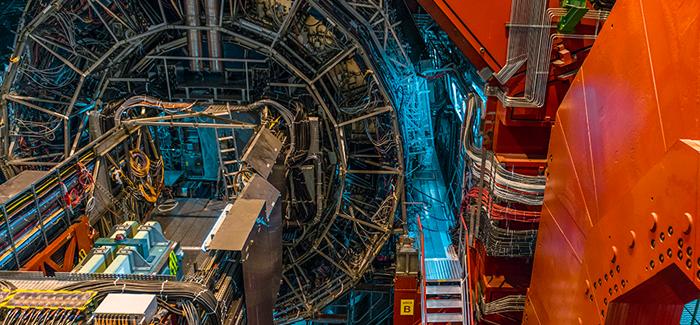
(Photography by Anna Pantella © 2013 CERN)
Theories and particles collide in a documentary that captures the tension and intensity of discovery.
A recent documentary about the search for the Higgs boson, Particle Fever, depicts physicists at work. They do not all labor alike.
Experimentalists at CERN, the European consortium where researchers discovered the Higgs particle—an essential missing piece to the understanding of the universe that explains why other particles have mass—come across as contractors at a multibillion-dollar construction site. They operate the Large Hadron Collider, a particle accelerator whose scale, precision, and complexity befit its massive purpose: recreating the conditions just after the big bang to reveal the origins and nature of the universe.
Theorists, on the other hand, use chalk to scribble scientific hieroglyphics on blackboards.
Moderating a panel of researchers as part of the University’s Science on the Screen series, physical sciences dean Edward “Rocky” Kolb summarized the distinction for his Logan Center audience. “It seemed that the accelerator builders and experimentalists wear hardhats, steel-toed boots, get dirty, crawl around,” Kolb said. Meanwhile, he went on, panelist and Institute for Advanced Study theoretical physicist Nima Arkani-Hamed, who is in the film, “sits in his office drinking coffee, drawing plenty of diagrams.”
A good sport, Arkani-Hamed played along with Kolb’s teasing vision of theorists with their feet up and heads in the stars. Then he explained the unseen forces roiling under the placid surface. “The daily life of a theorist, it looks like all fun and games,” Arkani-Hamed said, “but the daily life of a theorist is defined by failure.”
Day after brain-straining day turns into months, years, and decades of developing ideas only to risk their dismissal when the experimentalists produce the data.
At the Large Hadron Collider, the experimentalists encountered their own failures. In September 2008 the LHC went live with great fanfare. “Now comes the day of reckoning,” LHC project director Lyn Evans says in the film. “Five, four, three, two, one, now.” Nothing happened. “No beam.”
On the tense second attempt, to the physicists’ palpable relief and raucous delight, the collider generated a beam, then a second going the opposite way, which turned out to be just a tottering baby step. The two beams still needed to speed around the 17-mile ring and collide to produce the cosmic debris that could be measured and analyzed.
Before those collisions could happen, a “completely catastrophic” helium leak shut down the LHC for more than a year. “It was the biggest accident that’s ever happened at a particle accelerator, by far,” said panelist Joseph Lykken, the chief research officer at Fermilab and a physicist on one of the LHC experiments. About 50 magnets weighing 10 tons each were “tossed around like a train wreck.”
In Particle Fever, Arkani-Hamed criticizes the celebration that accompanied the collider’s debut as excessive and premature. The real work had not yet begun.
After 15 years of theorizing, he had reason to be anxious about what the particle accelerator’s data would reveal. “Depending on what happens with the LHC, these are 15 years I could come to see as the best possible thing I could have been doing with this time, or it could just be the entire 15 years might as well have not happened, no impact,” he says in the film. “And then that’s just 15 years that are gone. It’s not the sort of thing where there’s consolation prizes.”
To face such disappointment requires a doggedness that shakes off mistakes and accidents as inevitable in the service of transcendent science. “Jumping from failure to failure with undiminished enthusiasm,” says Stanford’s Savas Dimopoulos, SM’77, PhD’78, in the film, “is the big secret to success.”
Fast-forward, as Particle Fever essentially does, to the cusp of discovery in 2012. Accumulating data hinted at the Higgs’s existence and the looming questions focused on its mass. Where the particle fell on a spectrum of about 115 to 140 gigaelectron volts (GeV) would determine the validity of many theories of the universe. The reported mass of about 126 GeV neither confirmed nor ruled out most theories discussed in the film. The inconclusive result, Dimopoulos says, “is about as interesting as it could be.”
As UChicago physicist Marcela Carena put it at the Particle Fever panel, “Now that we arrived to the summit, we look and we see, ‘Oh my God, there are other summits a bit higher there and we need to arrive there.’”
The Higgs discovery represented the ultimate summit for one theorist. Peter Higgs, who posited the particle’s existence in the 1960s, attended the unveiling of the LHC data.
Higgs, the 2013 Nobel laureate in physics, dabbed away tears at the discovery he did not expect to live to see, if his namesake boson existed at all. Then he stood and cheered with the crowd gathered at CERN, a theorist applauding—and applauded by—the experimentalists who discovered the particle that he conceived.
